This tender Slow Roasted Prime Rib is the perfect centerpiece for a holiday dinner. Using a reverse-sear method creates a juicy and tender roast with a crisp outer crust.
There are few entrees more impressive than Slow Roasted Prime Rib for a holiday dinner. A perfectly-cooked standing rib roast, carved into juicy, rosy slices, makes a gorgeous presentation on a carving board or platter. Prime rib has become a luxurious yearly Christmas tradition for many families.
Given that prime rib can be costly, there can be a lot of pressure to get the cooking process “right.” Today, I’m sharing my shopping tips and preferred method for making an unforgettable slow roasted prime rib that will leave your guests coming back for seconds every. single. time.
What exactly is Prime Rib?
Prime rib (also known as “standing rib roast” when sold on the bone) is beef cut from the rib section; more specifically, ribs 6 to 10. This is the area where ribeye steaks originate. It’s meaty, well-marbled, and utterly delicious.
You can buy boneless prime rib, but I much prefer roasting on the bone for the best flavor, juiciness, and texture. Want to delve further into prime rib cuts? I love The Food Lab’s Definitive Guide to Prime Rib over at Serious Eats.
Shopping for Prime Rib
Is all Prime Rib Prime-Grade Meat?
Despite being known as “Prime” rib, this cut does not necessarily carry the USDA Prime grading. You can buy Prime Rib as USDA Prime or Choice. Marketed at a higher price point, a Prime-grade rib roast will be more marbled than Choice, improving flavor and texture.
(I love Prime-grade roasts, and even better, those that have been dry-aged. That said, I’ve also had many Choice-grade cuts that have been absolutely delicious. Especially when utilizing the reverse sear method described below.)
How should I ask for the prime rib to be cut?
When I buy prime rib, I like to ask the butcher to cut the roast from the loin end of the rib section (also known as the “first cut”), as opposed to the chuck end (the “second cut”). This is a personal preference; the loin end is typically a bit less fatty (though, still well-marbled) and more tender.
To make serving easier, I also ask the butcher to cut the meat off of the bones and tie it back on for roasting, as has been done here. When ready to serve, just snip away the twine, lift the meat from the bones, and carve.
How Much Prime Rib Should I Buy?
As a general rule, I plan on 1 pound per person when buying prime rib on the bone. You can expect to serve 2 adults per rib.
What is the Reverse Sear Method?
Many traditional prime rib recipes call for searing the meat either on the stove or in an ultra-hot oven to create an outer crust before slow roasting. The “Reverse Sear” method flips the process, first slow roasting the meat at 250 degrees F to your desired internal temperature. The meat is then rested and seared at 500 degrees F just for a few minutes before serving.
What’s the benefit to utilizing a reverse sear? The meat is incomparably tender and evenly cooked from end-to-end with a minimal area of overcooked “gray ring” on the interior.
Slow roasting the raw meat in a 250-degree F oven also results in less moisture loss. All of the drippings that are usually released into the pan with a high initial (or prolonged) cooking temperature remain in the roast. Slices of prime rib cooked with the reverse sear process are so juicy.
Beautifully crusted, rosy, juicy meat throughout the roast? Talk about the perfect prime rib!
Want to read more about reverse searing? Check out two of my favorite articles from Serious Eats and Bon Appétit.
How Should I Season Prime Rib?
I like to keep it simple with a generous coating of sea salt and freshly-cracked black pepper. To encourage a great crust, I season the meat the night before roasting, and let it stand uncovered in the refrigerator to dry a bit.
How Should I Serve Slow Roasted Prime Rib?
I love a good sauce, a potato side dish, and a green vegetable with a slice of prime rib.
If there’s any potential drawback to cooking a prime rib with a reverse sear, it’s the lack of drippings to make a pan sauce. Since all of those juices remain in the meat as it cooks, there isn’t much to work with in the pan afterwards.
By the same token, reverse-seared meat is so juicy, you don’t really need a pan sauce or jus.
I like to serve this prime rib with a complementary condiment, such as my Roasted Garlic and Horseradish Cream Sauce, and Duchess Potatoes. Creamy horseradish sauces are a classic pairing with prime rib, and go especially well with the tender meat.
Don’t forget the leftovers!
If you’re lucky enough to have leftover prime rib after a holiday dinner, it makes fantastic roast beef sandwiches, breakfast hash, or even Pho. This is a roast that you’ll want to make the absolute most of after the holiday!
Video Recap:

Slow Roasted Prime Rib
Ingredients
- 6 to 12 pound standing rib roast (bone-in prime rib)
- kosher or sea salt
- freshly-cracked black pepper
- Roasted Garlic Horseradish Cream Sauce (optional, for serving)
Instructions
- For ease in carving, ask your butcher to cut the meat off of the ribs and chine (backbone) and tie it back on.
- The day before you plan to roast your prime rib, season it liberally on all sides with salt and pepper. Place the roast on a heavy baking sheet with the fat cap side up and refrigerate, uncovered, overnight (or up to 24 hours).
- Remove the prime rib from the refrigerator and let stand at room temperature for 2 hours before roasting.
- Preheat oven to 250°F with the rack in the lower third of the oven. Place prime rib on a v-rack in a roasting pan with the fat-cap side up.
- Roast until an instant-read thermometer inserted into the thickest part of the meat (away from the bone) reads 120-125°F for rare, 128-130°F for medium-rare, or 132-135°F for medium and medium-well. This will take 3-4 hours.
- Remove the prime rib from the oven, tent with foil, and let rest for 30 minutes.
- Increase oven temperature to 500°F. Uncover the roast and sear it in the oven for 5-10 minutes, until the exterior is brown with a crisp crust.
- Carve the prime rib and serve with Roasted Garlic Horseradish Cream Sauce on the side.
Video
Notes
Oven Calibration
Especially when slow roasting at a low temperature, it's important to confirm that your oven is running true to temperature with a reliable oven thermometer before you get started. Read how to test it with this article from Fine Cooking.Nutrition Estimate
Nutrition information is automatically calculated, so should only be used as an approximation.
About our recipes
Please note that our recipes have been developed using the US Customary measurement system and have not been tested for high altitude/elevation cooking and baking.

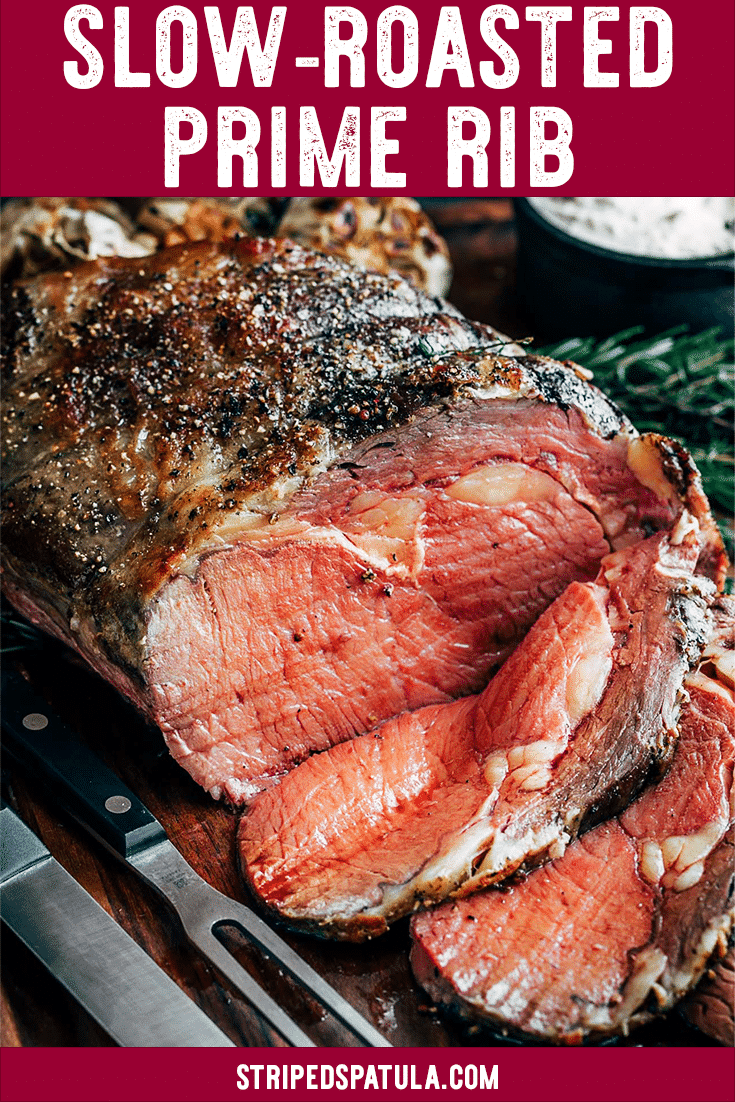
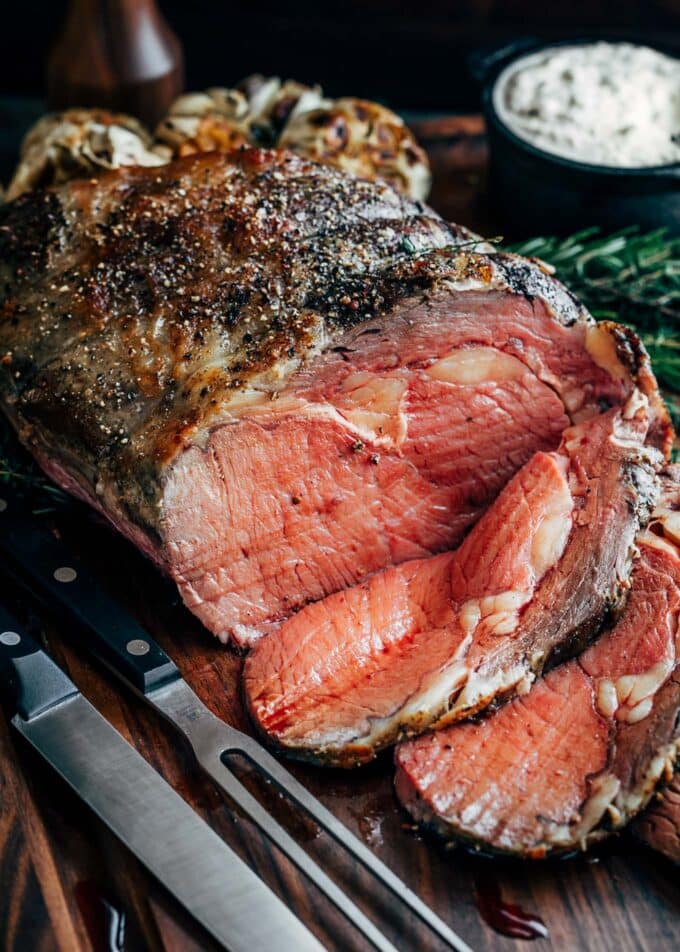

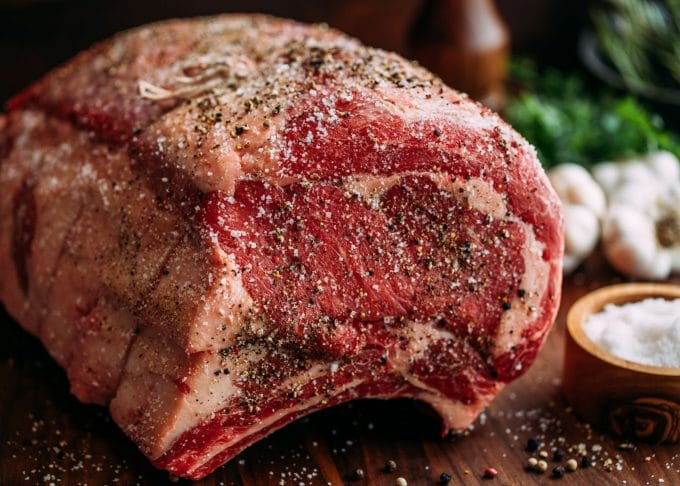
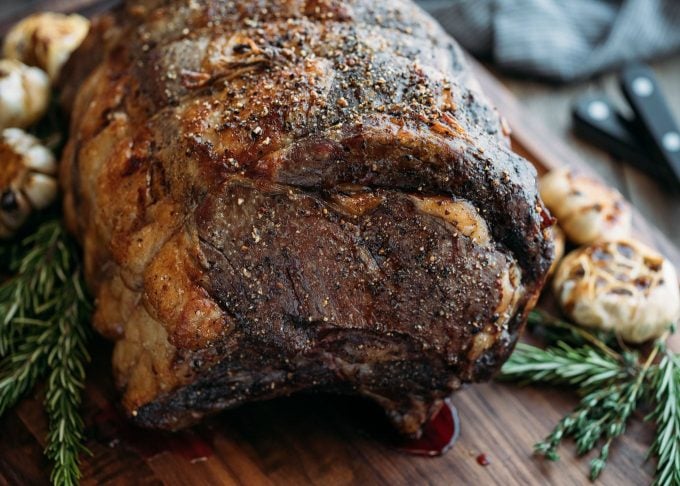
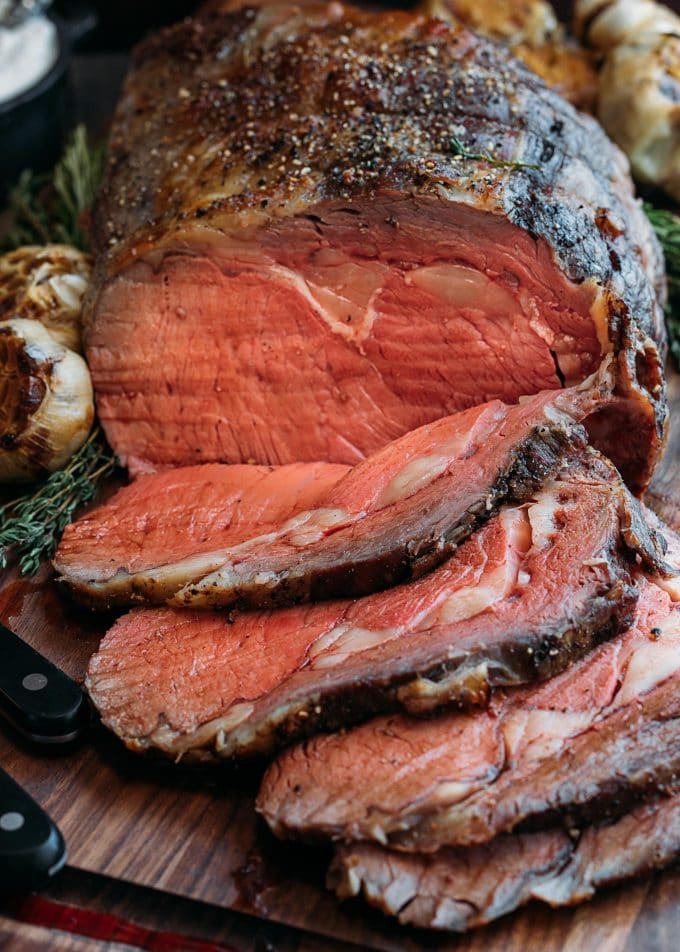














Just cooked our 6.5 lb prime rib roast this way today for Christmas. I wanted to try something different because using the traditional method where cranking up the heat first thing about smoked us out of house and home last year. Smoke alarms were going off, house filled with smoke, windows open in the middle of winter…and it is a cardinal sin to open the oven using the traditional approach. So there wasn’t much we could do, other than bare the misery. This version cooking with low temps initially and saving the high temp cooking for the end helped with that issue. And…the meat turned out really good. Saving this recipe! Thanks for posting it.
I just tried this recipe for Christmas dinner today. Wow! I will always use this method. It was as you said, juicy inside and crisp on the outside. Thank you.
Tried this last night. Best boneless roast we’ve ever had.
Cooked at only 200 degrees for 30 min/Lb. then removed from the oven at 130 internal temp. Turned oven to 550. When at temp, seared for 10 minutes.
Served immediately after removed.
The nice thing is that you can let it rest for up to 1 hour before searing to allow for slow eaters or other delays.
Medium Rare from edges to center!!
Hey I am wanting to use your recipe for Christmas dinner this year. I have a convection oven with an optional traditional bake setting. Should I use the traditional bake or go with the convection features? I think I will probably do the sear on convection but as for the slow bake…?
I am using a boneless rib roast… do you have an idea of the timing? Just trying to timeline my cooking.
Thank you so much!
Hi Marissa, I tested this one on the regular bake setting of my oven to accommodate the most readers. Convection will definitely give it a great sear at the end! Just keep an eye so it doesn’t burn. My convection cooks about 25% faster than my bake setting. A boneless rib roast typically takes a little less time, though I haven’t tested the reverse sear method with boneless, as we always buy bone-in. Merry Christmas!
I notice that the “slow roasting” temps from many sites recommend a 200 degree cook…yours is at 250. The meat has a shorter cooking time, but is there any other reason to cook it at 200 degrees? Big difference.
Hi Patricia,
Technically speaking, a 200 degree F oven is considered a “cool oven.” 250 is “very slow.” In my experience, 250 is warm enough to tenderize the meat the best, with the benefit of a slow roast. (Also, not all ovens can maintain a consistent heat below 250.) It’s the temperature most often recommended in reverse sear methods. Thanks for visiting!
Thank you for your recommendations. I am cooking a 6.6 # roast now. I peaked and it looks,fabulous. Will take it out when it hits,130
Wonderful, Peggy! I hope you enjoy this method for cooking Prime Rib as much as we do!
The recipe sounds great … once one converts to Celsius.
Just one weird thing … how could this be an entree? After eating this, there’d be no room left for a main course!
Hi Anthony. Here in America, “entree” refers to the main course. Thanks for visiting!
In the United States, an entree is often considered to be the main course.
I made this recipe tonight and it was amazing! I almost burnt the house down by having my oven at 500 degrees but it made the best crust! It was so easy and juicy!
What a great article, Amanda! So many good points there. I never knew that you could ask the butcher to cut the meat off the bone and then tie it back on. This is a great tip! The picture of the raw meat is one of the most mouthwatering meat photos I’ve seen and raw meat is rarely mouth watering. Well done!
I did this roast today for Christmas and it was great! Thank you!
Much better than the original method of sear first. This is it!
This is just absolutely gorgeous and such a great meal for a large crowd like we always have for the holidays! I love everything you have done with this, and the ease with which you describe it. Plus, that cream sauce sounds to die for! Merry Christmas!
What a fabulous post! You certainly covered everything there is to know about buying and making the perfect Prime Rib Roast – which is so important – who would want to ruin such a marvelous and pricey cut of meat!
I love the reverse-sear method as it always produce a wonderful, perfectly cooked meal. Love your photos too!! I am hungry now!!
Oh this looks amazing. I am so with you, roasting on the bone imparts so much more flavor than boneless. I haven’t made a good prime rib like this in a while, and I think it’s high time I changed that
I love your explanations. This is a great article. I have tried reverse searing and love it! I learned about it from ATK but some of those guys are over at Serious Eats now. The roast looks AMAZING, I will be right over;P
Amanda, as someone who has never cooked prime rib before for the very reasons you mentioned, I so, so appreciate your thorough, thoughtful post. This gives me a ton of confidence to try this! It sounds absolutely delicious, looks totally doable, and btw, your photography is stunning!
I’ve cooked our rib roasts this way for the past few years. I will NEVER return to the “traditional” method. Try doing it this way. I promise you’ll love it. Really.
It’s not even 10am but I want this prime rib in my life IMMEDIATELY. It looks so perfectly cooked – nice job!!
Oh my what a great recipe. I could see making this for New Year’s Eve dinner. Perfect dinner for bringing in the New Year.
I’m giving you big props Amanda, because this roast looks absolutely stellar. I’m going to share the reverse sear method with my mother who incidentally overcooked the roast last year. Our problem is that she’ll cook the meat and let it rest while we have a first course — but there are a few slower eaters, so by the time everyone is finished with the first — the meat has set for quite a bit longer and continued to cook. I think this would solve that problem — just cook it in between first course and the main. Beautiful photos.